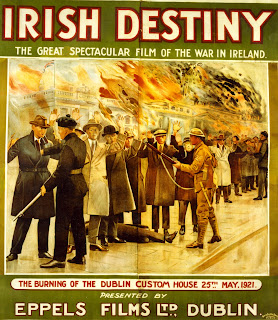The IFI’s home in Temple Bar is all about the people who
come here to engage with our extensive programme, so when we started to plan
our anniversary celebrations, we very quickly decided that we wanted the focus
to be on our audiences. We wanted to celebrate the experiences that our
audiences have had here over the last 20 years by reliving some of the big
moments whilst also looking to the future.
For those who have strong memories of films that they’ll always associate with the IFI, we presented a season of 20 Landmark Films which featured big IFI titles including Natural Born Killers, Vertigo (on 70mm) and Mulholland Dr. Our Open Weekend threw our doors open for two days of free screenings and events for old and new audiences. We had queues from 7am which stretched up Eustace Street and down as far as the Olympia Theatre on Dame Street! We had a 1992 Day, a series of blogs throughout the month written by guest contributors, a pub quiz, DJs, a pop-up museum, tours of the IFI Irish Film Archive, Irish shorts from every year of the last 20, afternoon talks, discussions, archive and family screenings, and the unveiling of newly commissioned pieces of artworks. To close the proceedings, we were delighted to screen the European premiere of What Richard Did, the latest film by leading Irish director, Lenny Abrahamson.
IFI Open Weekend 2012
As we come to the end of a fantastic month, I think we managed to achieve what we set out to do. We greeted new audiences and welcomed back many faces who hadn’t been for some time alongside our faithful regulars. There was an amazing energy in the building throughout the month as audiences really engaged with all of the celebratory events and it generated a sense of enthusiasm for what the IFI has achieved over the last 20 years and excitement about what lies in store for its next chapter.
Paul Lynch, Sinéad Cusack and Jeremy Irons - Waterland
There are so many people to thank for the blood, sweat and tears that have been put into the IFI, both over the last 20 years and indeed back to our origins in 1943. There have been successive dedicated Boards, Councils, Directors and staff who have all helped shape our story and, as we look back, each and every person involved should take a bow as I think we have achieved the original vision of becoming a thriving, accessible, relevant and vital institution which now has a central role to play in Ireland’s cultural landscape.
The Archive’s Oscar and Emmy statuettes on a permanent display
So as we close the page on the chapter of the last 20 years, we now look forward to an exciting new phase in the organisation’s story. The IFI is at an exciting point; as we look to the future, we are about to announce the findings of a major IFI Education research report, Film Focus, which could help to define the role of film in the curriculum and shape media literacy strategy. Next year we will open a brand new second home for the IFI Irish Film Archive with additional vaults at NUI Maynooth so we have the capacity to continue to ensure the preservation of Ireland’s moving image heritage. And we have exciting exhibition programmes, both in Ireland and abroad (with a focus on celebrating the EU Presidency with Irish film programmes across Europe in the first six months of 2013) which we hope will continue to engage and enthral a variety of audiences.
Here’s to the next 20 years!
Ross Keane
Director

.jpg)

.JPG)



.jpg)





.jpg)
.jpg)

















.jpg)

small.jpg)















